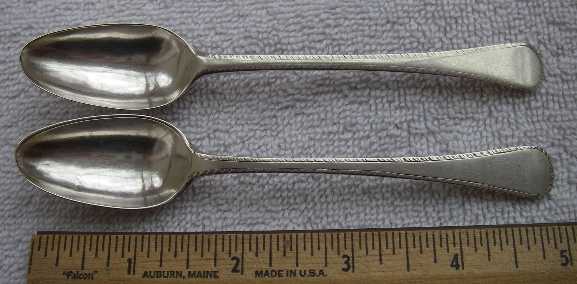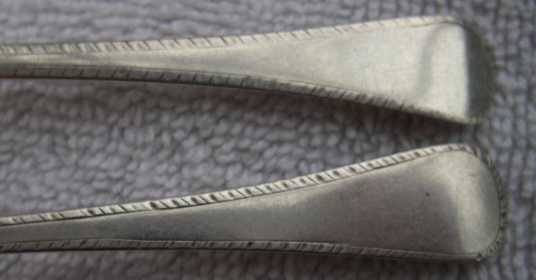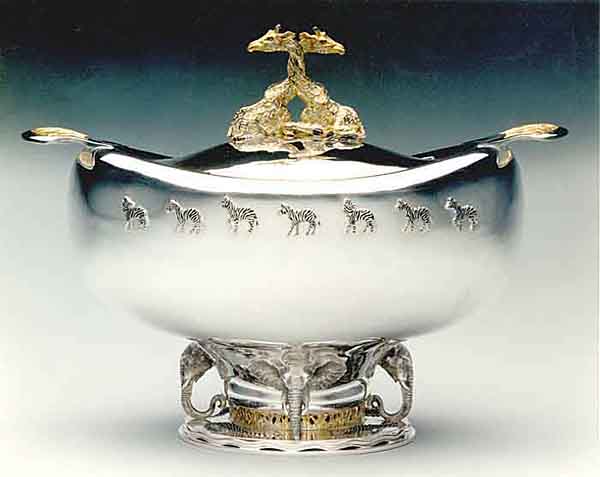|
A GLOSSARY of MILLED BANDS
|
|
| How to Post Photos |
REGISTER (click here)
|
|
A GLOSSARY of MILLED BANDS
|
|
| How to Post Photos |
REGISTER (click here)
|

|
 SMP Silver Salon Forums SMP Silver Salon Forums
  American Silver before sterling American Silver before sterling
  A feather-edge conundrum A feather-edge conundrum
|
| next newest topic | next oldest topic |
| Author | Topic: A feather-edge conundrum |
|
Brent Posts: 1507 |
  
  Here is an interesting pair of spoons that seems to raise more questions than it answers. The basics are this: two seemingly identical feather edge teaspoons, about 5 inches long. To the casual glance they seem to be a true pair. HOWEVER.... They bear two different marks. One is the [G:M] recently attributed to one Gideon Myrick of Eastham, MA. The other mark is an [IM] normally attributed to Joseph Moulton III of Newburyport. Both spoons have the same CG monogram, but the engraving differs slightly, such that it was likely done by two different people. According to Patricia Kane, the first person to attribute the GM mark to Myrick, Myrcik died at sea around 1760 (the details of his life are fuzzy, and there are few records pertaining to him). If this spoon is the work of Myrick, and he did die in 1760, it would be a very early example of a feather edge in the colonies. The other known examples of Myrick's spoons are all in the Hanoverian style, which would be appropriate for pre-1760. So, how about the second spoon? I would have to guess that it was made by Moulton specifically to match the other. Assuming this is correct, he did a very good job of matching. Anyway, an odd "pair" of spoons! I'd be interested in any insights or alternate theories as to how these came to be. Brent IP: Logged |
|
bascall Posts: 1629 |
  
Maybe it was an addition that occurred not too many years after the original spoon or spoons were made, or partners took a little artistic license with there work in a group order? IP: Logged |
|
agphile Posts: 798 |
  
If the GM spoon was indeed made before 1760 in that style it would be exceptionally early in England. The Old English style, and feather-edging, really only appears here during the 1760s, becoming more common towards the end of that decade and into the 1770s. As Old English became fashionable it was fairly common practice to take Hanoverian spoons in to the silversmith to be "turned". Assuming things were not too different in America,I would suggest that the likely scenario is a Hanoverian spoon being turned some time in the 1770s and decorated with feather-edging at the same time, possibly to match new feather-edged spoons, or new feather-edged spoons were acquired a bit later to add to the "turned" set. Of course, if 1760 is not the end point for dating the GM spoon it could simply be a matter of a new spoon being added to an unaltered set so it is down to how confident one can be about dating the marks. [This message has been edited by agphile (edited 01-07-2009).] IP: Logged |
|
swarter Moderator Posts: 2920 |
  
Well, this one is certain to generate some discussion! In the first place (based only on what is in Kane's book) the attribution to Myrick is only tentative, and there is no indication of his time of death (Brent, have you additional information from her?). In fact the indication that he was lost at sea is not convincing since his father was lost at sea in the 1840's, and the account of the son's loss in based on mention in someone else's family history, and could be a conflation in the writer's memory based on the father's loss (such is not uncommon in family histories). Life at sea was indeed hazardous in those days, but how likely is it that both father and son would fall overboard and be lost twenty years apart? So it is possible that he might have lived beyond that date and the spoon could be later than 1760. Be that as it may, I think the spoon really is early, based on the placement of the initials on the back of the downturned spoon, which I think is original in that configuration. It was customary to place initials in that position on Hanoverian spoons, and on the top in downturned ones. It would be understandable that someone used to placing initials in one place would do the same if the spoon were not an established style with the other convention already established when it was made. There is a ridge on the back, and had the spoon been "turned" (by cutting the stem and inverting the handle, which I have seen to have been done) the initials would also have been reversed and now be on the top. They would not have been on the top in the hanoverian. Had the handle been reworked rather than cut, the initials would have been obliterated, and likely would not have been put on the back at the later period. Ridges on the back are more frequently found on earlier spoons, and lost later as in the Moulton example. The Moulton spoon, then, would have been done later to match the earlier one, and the initial position copied, along with the letter style (but with the conventional later form of the device between them). Just my two cents. [This message has been edited by swarter (edited 01-07-2009).] IP: Logged |
|
agphile Posts: 798 |
  
I probably ought not to chip in too much about American silver but I wonder whether what happened in England offers some help on the question of dating. The earliest feather-edge spoons I have are from 1767. There are contemporary references to “gadrooned” spoons in 1766 and “laureld” spoons in 1769, either or both of which terms seem probably to refer to what we now call feather-edging. Most surviving feather-edged spoons are from the 1770s. In London top marking was introduced in the 1781-2 assay year. Prior to that Old English as well as Hanoverian spoons were bottom marked. So, as seen from this side of the Atlantic, if the maker GM was still active for some time after 1765 there is no need to hypothesise about a Hanoverian spoon being turned. Indeed, the spoon may well be evidence for such an extended working life as Swarter implies. My “turning” theory is only relevant if you are certain the spoon is earlier in which case I believe it most likely that the upper stem of a Hanoverian spoon has been re-shaped – and Swarter has rightly pointed out that, if so, the inscribed initials must have been done after the re-shaping. IP: Logged |
|
Brent Posts: 1507 |
  
Thank you both for your input! Fortunately, this exercise has helped me to get my facts straight. The new catalog of silver from the MFA Boston includes a tablespoon by Myrick. In the heading to the entry, they give an approximate death date of 1760. I thought I had remembered a similar guess in Kane's book, so I let it go. On reviewing the entry in Kane, though, I find that there is no death date at all, guessed or otherwise. In fact, one of the known pieces of Myrick silver listed in the entry is a tablespoon with an approximate date of 1775! So, the assumption must be that he lived into to 1770s at least. I don't know where the MFA got the idea that he died around 1760; they don't give any more information. Swarter, you make a good point that is it unlikley that both Myricks died at sea. It seems likley that the family history got muddled at some point, with the manner of death perhaps being switched from father to son. I don't see any evidence of alteration on either spoon, so I am confident that the spoons were both intended as downturned feather edge. I HAVE seen a spoon that was reversed; a wonderful Adrian Bancker tablespoon that had been cut near the bowl juncture, the handle flipped over, and reattached with a lap joint. I also find it interesting that these spoons demonstrate the gradual increase in size of the teaspoon. At 5 inches, they are bigger than the typical Hanoverian style teas from a few years earlier, bit not quite as long as the early federal spoons from the 1780s and 90s. Thanks again! Brent IP: Logged |
|
FredZ Posts: 1070 |
  
Brent, I am curious about this new book. "The new catalog of silver from the MFA Boston includes a tablespoon by Myrick." Any info on how to acquire a copy? These are nice spoons! Best, IP: Logged |
|
swarter Moderator Posts: 2920 |
  
Fred, the book is Silver in the Americas, 1600-2000, American Silver in the Museum of Fine Arts, Boston, Jeannine Falino and Gerald W.R.Ward, Eds. It is presented for continuity as vol 3 of the earlier catalog by Kathryn Buhler, but is not matching in form or method of treatment. It includes only those accessions made since the time of the earlier volumes (there have been quite a few). Obviously, it is a "must have." IP: Logged |
|
Brent Posts: 1507 |
  
Thanks for providing the details for Fred. The book includes a fairly large array of Arts & Crafts pieces, including pieces by Henry Petzal, Maria Reignier and others. A nice catalog with lots of good scholarly information. IP: Logged |
|
wev Moderator Posts: 4121 |
  
Is there an isbn? I can't find it on the MFA site or Amanzon IP: Logged |
|
adelapt Posts: 418 |
  
Publisher: MFA Publications 2007. ISBN 0878467211 Readily available - good luck. IP: Logged |
|
swarter Moderator Posts: 2920 |
  
quote: You can probably find it through www.AddALL.com and/or www.used.addall.com , both new and used (separate sites - link to each on the other) [This message has been edited by swarter (edited 01-08-2009).] IP: Logged |
|
middletom Posts: 467 |
  
Swarter, Any mention of ONC in that book? I know it is highly unlikely. We once issued an invitation to their American silver department to come visit us and see our work. We never had a response, though we do qualify for the date span of 1600-2000. I guess we aren't artsy-craftsy enough for them. middletom IP: Logged |
|
swarter Moderator Posts: 2920 |
  
Not by that name. There is a Museum commissioned bowl by Robert Butler, though, together with a nice little write up of him. IP: Logged |
|
Scott Martin Forum Master Posts: 11520 |
  
Was it this?  IP: Logged |
|
swarter Moderator Posts: 2920 |
  
quote: One and the same.... A magnificent piece. [This message has been edited by swarter (edited 01-10-2009).] IP: Logged |
All times are ET | next newest topic | next oldest topic |
  |
|
Ultimate Bulletin Board 5.46a
|
1. Public Silver Forums (open Free membership) - anyone with a valid e-mail address may register. Once you have received your Silver Salon Forum password, and then if you abide by the Silver Salon Forum Guidelines, you may start a thread or post a reply in the New Members' Forum. New Members who show a continued willingness to participate, to completely read and abide by the Guidelines will be allowed to post to the Member Public Forums. 2. Private Silver Salon Forums (invitational or $ donation membership) - The Private Silver Salon Forums require registration and special authorization to view, search, start a thread or to post a reply. Special authorization can be obtained in one of several ways: by Invitation; Annual $ Donation; or via Special Limited Membership. For more details click here (under development). 3. Administrative/Special Private Forums (special membership required) - These forums are reserved for special subjects or administrative discussion. These forums are not open to the public and require special authorization to view or post. |
|
copyright © 1993 - 2022
SM Publications
All Rights Reserved. Legal & Privacy Notices |